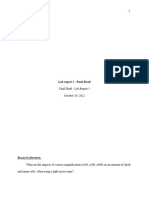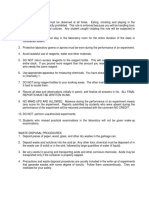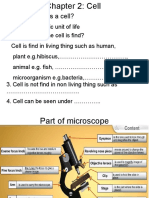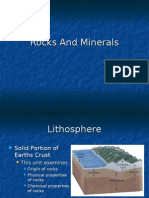Example of Lab Write Up
Uploaded by
joshua.brussellExample of Lab Write Up
Uploaded by
joshua.brussellExample of Lab Write up
Microscope Measuring
Purpose: To practice measuring small objects underneath a microscope.
Hypothesis: My cheek cell will be 25 µm long.
Materials: Cheek cells, microscope, microscope slide, cover slip, water, iodine, ruler.
Procedures:
1. Place ruler below the objectives on the microscope and measure the field
of view under low power in millimeters. Make a sketch of what you see
under the ruler under the microscope.
2. Take a toothpick and rub the inside or your cheek with it.
3. Put a drop of water on a microscope slide and then swish the tip of the
toothpick around in the water to deposit check cells on the slide.
4. As one drop of iodine to the water to stain the check cells.
5. Place cover slip on slide and then place slide under the objectives on the
microscope to view.
6. Make a sketch of the check cells under low power.
7. Find a check cell under high power and sketch this cell as well.
8. Calculate the field of view under high power and figure out how long your
cheek cell is.
Data:
Your sketches should look like this, well not exactly like this,
but a sketch version of this, drawn as accurately as you can of course!
Notice how round the circles are, you can use something to
Trace such a nice circle!
Analysis: This is where you will show your calculations for this
lab. In other labs you will discuss what your data is telling you.
Conclusion: Restate your hypothesis and say whether it is correct or not.
You will then discuss what went wrong and what you could have done better.
You might also like
- Drosophila (A Fruit Fly) ? Please Give Reasoning Behind The Answer. WhichNo ratings yetDrosophila (A Fruit Fly) ? Please Give Reasoning Behind The Answer. Which4 pages
- A LESSON PLAN in SCIENCE 6 Vertebrates and Invertebrates100% (2)A LESSON PLAN in SCIENCE 6 Vertebrates and Invertebrates6 pages
- STEM Microscope Lab: Purpose: The Purpose of This Project Is To Practice Using The LabNo ratings yetSTEM Microscope Lab: Purpose: The Purpose of This Project Is To Practice Using The Lab9 pages
- Practice Nº3. Human Cheek Cells: ActivitiesNo ratings yetPractice Nº3. Human Cheek Cells: Activities1 page
- Microscopes and Cells: Name - TA NAME - SECTION#No ratings yetMicroscopes and Cells: Name - TA NAME - SECTION#5 pages
- Through a Microscope Something of the Science Together with many Curious Observations Indoor and Out and Directions for a Home-made Microscope.From EverandThrough a Microscope Something of the Science Together with many Curious Observations Indoor and Out and Directions for a Home-made Microscope.No ratings yet
- Using Microscopes: Starter: Thinking Ideas (TW)No ratings yetUsing Microscopes: Starter: Thinking Ideas (TW)17 pages
- Year 11 General Human Biology - Lesson 3No ratings yetYear 11 General Human Biology - Lesson 33 pages
- Virtual Lab 1. Introduction To The Microscope: Senior High School DepartmentNo ratings yetVirtual Lab 1. Introduction To The Microscope: Senior High School Department5 pages
- Unit One: What You Need To Know at First!No ratings yetUnit One: What You Need To Know at First!18 pages
- LAB04: Forensic Entomology: REQUIRED READINGS (Please Read Prior To Attending Lab Section)No ratings yetLAB04: Forensic Entomology: REQUIRED READINGS (Please Read Prior To Attending Lab Section)6 pages
- Application Datasheet: Standard Designation For Wrought Copper AlloysNo ratings yetApplication Datasheet: Standard Designation For Wrought Copper Alloys72 pages
- Behavioral Science Intelligence AssignmentNo ratings yetBehavioral Science Intelligence Assignment3 pages
- ANPH-M1-CU2. The Cell & Cellular Metabolism and Reproduction (Mitosis and Meiosis) PDFNo ratings yetANPH-M1-CU2. The Cell & Cellular Metabolism and Reproduction (Mitosis and Meiosis) PDF26 pages
- TheLoveLettersofVictorHugo18201822 10018235No ratings yetTheLoveLettersofVictorHugo18201822 10018235282 pages
- Mirror Neurons, Psychoanalysis, and The Age of EmpathyNo ratings yetMirror Neurons, Psychoanalysis, and The Age of Empathy18 pages
- Freshwater ecology concepts and environmental applications 1st Edition Walter Kennedy Dodds - The special ebook edition is available for download now100% (1)Freshwater ecology concepts and environmental applications 1st Edition Walter Kennedy Dodds - The special ebook edition is available for download now53 pages
- Applied Plant Physiolog y For AgroforesNo ratings yetApplied Plant Physiolog y For Agrofores11 pages
- Craniofacial Embryogenetics and Development 2. ed Edition Geoffrey H. Sperber All Chapters Instant Download100% (12)Craniofacial Embryogenetics and Development 2. ed Edition Geoffrey H. Sperber All Chapters Instant Download50 pages
- Allison Kaufman, James C Kafman, and Josep Call - The Cambridge Handbook of Animal Cognition (2021, Cambridge University Press) - Libgen - LiNo ratings yetAllison Kaufman, James C Kafman, and Josep Call - The Cambridge Handbook of Animal Cognition (2021, Cambridge University Press) - Libgen - Li832 pages
- Lecture 1 Introduction To Biochemical EngineeringNo ratings yetLecture 1 Introduction To Biochemical Engineering62 pages





































































































